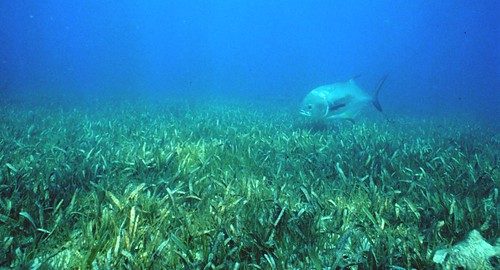
Just off Florida’s 8,000 miles of coastline and tidal areas, in shallow sunlit waters, over two million acres of seagrass meadows waft in the ocean currents.
Besides providing food and habitat for manatees, sea turtles, shellfish, and other animals, seagrasses protect coasts from erosion and store vast quantities of carbon dioxide.
“Seagrasses grow off the coast of many other U.S. states, including North Carolina and Virginia, as well as around the world,” said U.S. Forest Service Southern Research Station scientist Zanethia Choice. “Globally, their economic value is nearly $4 trillion.”
Although more closely related to lilies than to terrestrial grasses, like most of their distant grass kin, seagrasses require plenty of sunlight. Poor water quality reduces the amount of sunlight that reaches them, and seagrasses around the world are threatened by practices that affect water quality such as wastewater disposal and fertilizer runoff.
Choice, a natural resource specialist at the research center’s Center for Bottomland Hardwoods Research, and her colleagues from the University of Florida recently studied light requirements for four common seagrass species along the Florida Gulf Coast. The study was published in the Marine Pollution Bulletin.
“We found a direct relationship between the amount of light reaching the ocean floor and the amount and diversity of seagrasses growing there,” said Choice.
In 90 percent of sites where 13 years of historic data showed that adequate sunlight had been reaching the ocean floor, researchers found thriving seagrass meadows. However, areas with suitable light but no seagrass were most likely due to unsuitable substrate, temperature, and the amounts of dissolved salts and oxygen.
Seagrasses are adapted to nutrient-poor waters. When nutrients – whether from fertilizer runoff, wastewater disposal, or other human activities – wash into the ocean, they float suspended in the ocean waters. Seagrasses cannot use these suspended nutrients very efficiently, but tiny algae called phytoplankton can. Phytoplankton thrive in nutrient-rich waters, and as they grow, they intercept light and shade the ocean floor. Seagrasses were notably absent from areas with high nutrient levels.
Some seagrasses such as star grass could survive with as little as 8 percent of sunlight reaching the ocean floor, while other species required 25 percent sunlight or more.
“Light requirements for all the seagrasses we studied differed from previous findings at other locations,” said Choice. “The differences are probably due to morphological and physiological differences, and adaptation to light histories at specific locations.”
Understanding the light requirements of different seagrass species is essential for coastal managers who want to maintain seagrass habitats, and managing for seagrass health also provides water quality targets that can benefit other marine life.
